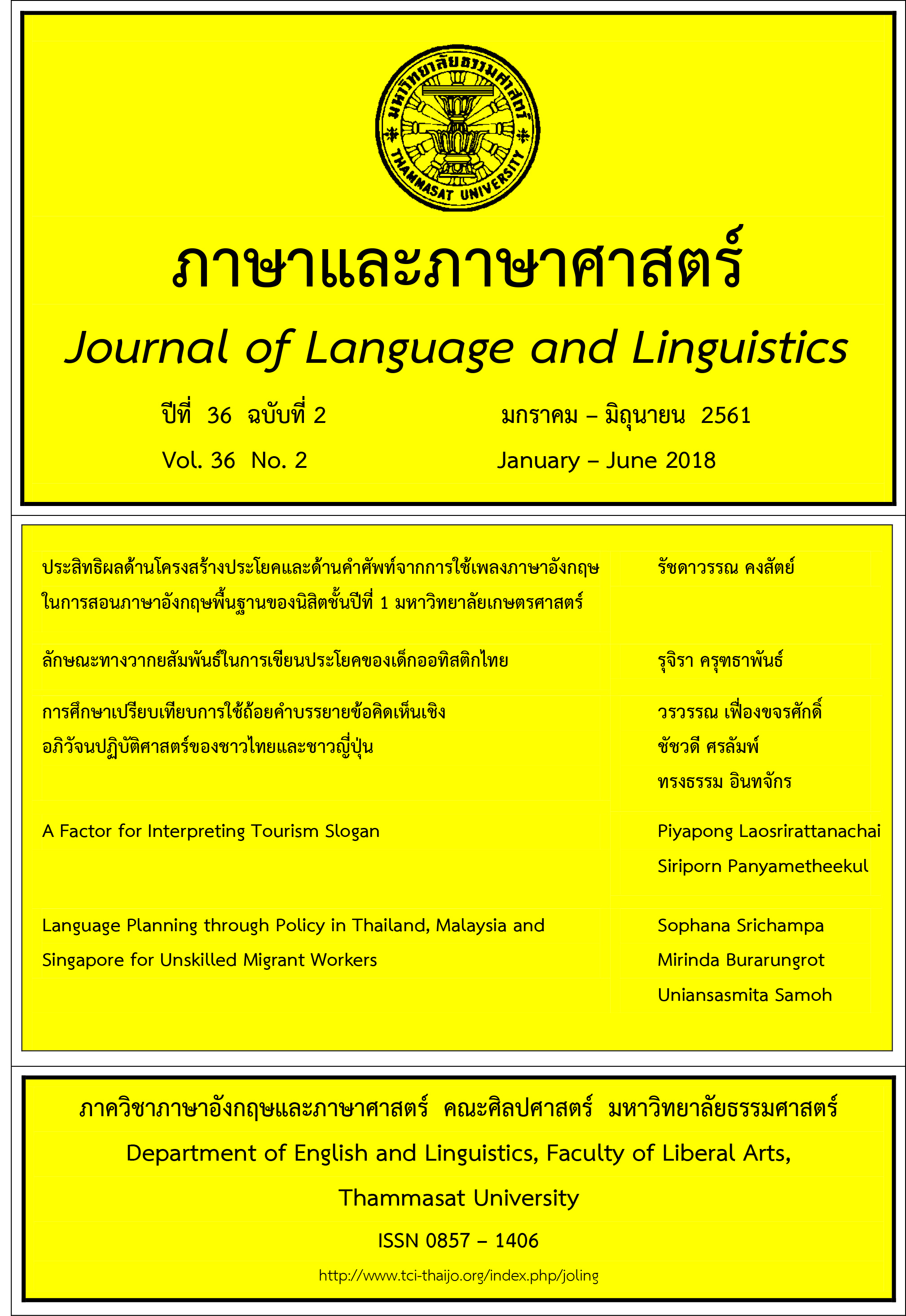The Effectiveness of Using Songs in Teaching Grammatical Structure and Vocabulary: The case of Kasetsart University students’ first year English
Main Article Content
Abstract
The purpose of this study is to test the effectiveness of using English songs in teaching grammatical structure and vocabulary to university students as well as to investigate the use of song activities to promote students’ knowledge on grammatical structure and vocabulary. The study was conducted with first year university level students at Kasetsart University, Kampangsaen Campus. Two participating groups each composed of 40 students were selected randomly. The control group was taught in traditional methods without any teaching of songs. The experimental group was taught new vocabulary and the same grammatical structure with the help of selected songs and class activities including singing and exercises. A pre-test and a post-test were given to the two groups measuring students’ grammatical structure and vocabulary competence. The findings of the experimental group presented a significant improvement of English vocabulary and grammatical structure. This study shows that the use of songs plays an important role in teaching English as a foreign language.
Article Details
บทความทุกบทความเป็นลิขสิทธิ์ของภาษาและภาษาศาสตร์
References
_______________. (2552). หลักสูตรการศึกษาปฐมวัย พุทธศักราช 2546. กรุงเทพฯ: กระทรวงศึกษาธิการ.
มาริสา กาสุวรรณ์ และมณฑา จาฏุพจน์. (2013). ประสิทธิผลของกิจกรรมเพลงภาษาอังกฤษต่อการเรียนรู้และความคงทนของค าศัพท์และทักษะการพูด. วารสารศิลปศาสตร์ มหาวิทยาลัยสงขลานครินทร์, 5 (2),
18-31.
Abbot, M. (2002). Using music to promote L2 learning among adult learners. Retrieved from http://onlinelibrary.wiley.com/doi/10.1002/j.1949-
3533.2002.tb00061.x/abstract. Cullen, B. (1999). Song Dictation. Retrieved from http://iteslj.org/Techniques/Cullen-SongDictation.html.
Kara, Z. & Aksel, A. (2013). The effectiveness of music in grammar teaching on the motivation and success of the students at preparatory school at Uludag. Procedia – Social and Behavioral Sciences, 106, 2739-2745.
Kuśnierek, A. (2016). The role of music and songs in teaching English vocabulary to students. Retrieved from http://www.worldscientificnews.com/wpcontent/uploads/2015/10/WSN-431-2016-1- 55.pdf.
Larsen-Freeman, D. (2003). Teaching language: From grammar to grammaring. Boston, MA: Thompson-Heinle.
Millington, N. (2011). Using songs effectively to teach English to young learners. Retrieved from file:///C:/Users/Acer%20i3/Downloads/MillingtonUsingSongsEffectivelytoTeachEnglishtoYoungLearners.pdf
Nation, I.S.P. (2001). Learning vocabulary in another language. Cambridge: Cambridge University Press.
Okello, S., Piippo, A. and Wang, W. (2011). Grammar along: teaching grammatical bundles through song. In New Horizon: Striding Into the Future Proceedings. Michigan Teachers
of English to Speakers of Other Languages Conference, Kalamazoo, (pp. 50-60).
Paquette & Rieg. (2008). Using music to support the literacy development of young English learners. Early Childhood Education Journal, 36, 227-232.
Peacock, M. (1997). The effects of authentic materials on EFL learners. London: Oxford University Press.
Roslim, N., Azizul, A. F. & Zain, M.M. (2011). Using songs in enhancing the teaching of grammar. Retrieved from https://eric.ed.gov/?id=EJ1131405.
Saricoban, A. (1999). The teaching of listening. Retrieved from http://iteslj.org/Techniques/Saricoban-Songs.html
Saricoban, A. & Metin, E. (2000). Songs, verse and games for teaching grammar. The Internet TESL Journal. http://iteslj.org/Techniques/Saricoban-Songs.html.
Schoepp, K. (2001). Reasons for using songs in the ESL/EFL Classroom. Retrieved from http://iteslj.org/Articles/Schoepp-Songs.html
Sevik, M. (2012). Teaching listening skills to young learners through "Listen and Do" songs. English Teaching Forum, 50 (3)10-17.


